Just as you reach the top you hear an enormous crash. To your horror, the elevator cable has broken, and you go hurtling down toward the ground. You rapidly accelerate for the first few seconds, quickly reaching the elevator's terminal velocity of about 200 km/hr. At this constant speed, you don't really feel like you're falling, except for the loud roar, but you know what's coming next. It's time to brace for the impact.

The question that now faces you is: what is the safest thing to do? Let's do a few thought experiments.
Strategy 1: Jump. If the current of a river were to pull you downstream, you could slow your downstream speed by swimming in the opposite direction. Similarly, in an elevator that is carrying you downward, jumping upward just before impact will slow your downward speed. So, the first theory goes, it's best to jump.
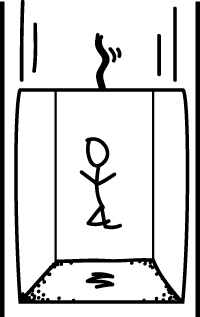
The first problem with this is that it is very sensitive to timing. To be most effective, you must jump in the moment just prior to reaching the ground. And, if you happen to jump to early and begin falling down again just before impact, then you will actually have increased your downward speed.
The second problem is that it won't make much of a difference. The terminal velocity of the elevator is around 200 km/hr. Your jump will at best reduce your speed by 10 km/hr. This is not enough to have much of an effect on you being squashed.
Strategy 2: Lie Down. When you stand up on your bed, you sink in much farther than when you lie down flat. That's because when you're standing, the force of your weight is concentrated on the small area of your feet, as opposed to being spread out across your entire body when you lie down. The same thing happens during an elevator crash when you are lying down: the force gets spread across your entire body instead of being concentrated on your feet.
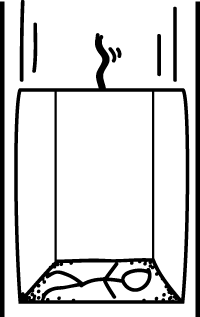
But a human is not a rigid body, and so force does not spread out that well. Think about how it feels when you belly-flop into a pool. That's the force of gravity spread out across your entire body, and it doesn't feel good. You can break your back that way if you jump from a serious height. Moreover, life-supporting body parts like your head and chest are unprotected, lying in direct contact with the ground. So, this technique may actually increase your chances of dying.
Strategy 3: Stand knees relaxed, arms in, preparing to collapse. This is the Parachute Landing Fall (PLF), designed for early paratroopers and round-canopy skydivers.
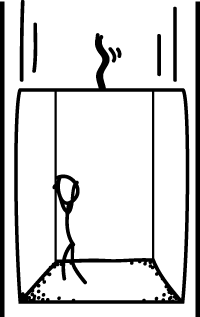
These skydivers would be falling around 40km/hr with lots of heavy gear, and so the PLF was designed to minimise injury.
The idea is to treat the body like a spring, absorbing the impact by allowing yourself to crumple and roll. It also allows your important internal organs to be protected by the rest of your body as you hit.
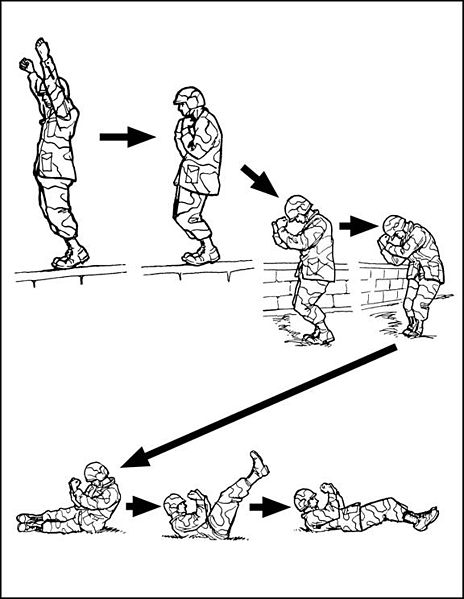
Of course, the elevator is much faster than the parachutist, and the effectiveness of this technique is not well-tested. You also don't know when the elevator is going to land, making it a bit like doing a PLF at night. So, practising a PLF appears to be the best elevator survival training that you can do.
Think now about what we have just discussed. The issue was inherently empirical: what is the safest way to fall in an elevator. And yet the entire discussion was carried out at the level of hypothetical thought experiments, most of which we could not easily test even if we wanted to (not ethically at least). What is the nature of these thought experiments? Did they teach us something about the natural world, and if so, how?
Introducing thought experiments
Pervasive in science
Thought experiments are useful practical tools. As a consequence, they are pervasive in science. For example, you might have noticed this kind of thinking portrayed in the movie Theory of Everything, in which Stephen Hawking imagines tracing the history of the universe backward in reverse in order to argue for the existence of the big bang.

Image Credit: John D. Norton
The evolution of the universe in reverse is not an experiment that can be done in real life, nor is it a purely mathematical calculation. It is a thought experiment.
Thought experiments are powerful tools that have been used throughout the history of science. One of the most famous examples is the following, which Galileo used to argue that heavy objects and light objects fall at the same speed.
Consider a light mass that is tied to the top of a heavy mass, and falling near the earth.

Galileo reasoned that the two masses are together heavier than the large mass alone. So, on the one hand, if a heavy object did fall faster than a lighter one, then the combined masses would fall faster than the large mass would by itself. On the other hand, since the small mass is supposed to fall slower than the larger mass, it should cause drag, slowing the combined body.
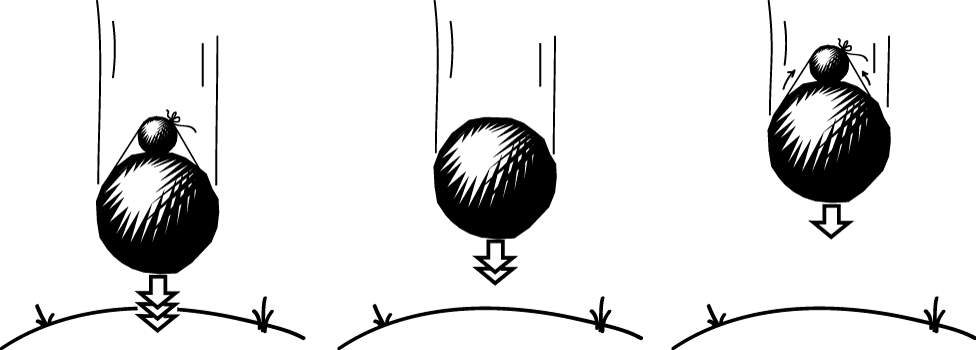
This is a contradiction — the combined body cannot fall both faster and slower than the large mass. Therefore, Galileo said, the speed of a falling body cannot depend on its mass. This is often said to be one of the simplest and most elegant thought experiments ever done.
Thought experiments are useful. They are pervasive in science. But you might have felt a slight nervousness about them. And you should. These thought experiments are in your head, but still provide knowledge about the natural world. How is that possible? This is known as the Epistemological Problem of thought experiments.
Epistemological Problem of Thought Experiments
Thought experiments are supposed to give us knowledge of the natural world. Where does this knowledge come from?
The puzzle is especially sharp if you think that knowledge of the natural world comes from observation. Are thought experiments somehow avoiding this requirement? If so, how? And if not, then why does a thought experiment work at all?
The 'Beyond Empiricism' View
One perspective on this claim argued by the philosopher James Brown is that thought experiments transcend empiricism. Most of our knowledge about the natural world of course comes to us from observation. But, according to Brown, there are some truths about the natural world that do not come from observations. Thought experiments are supposed to provide access to some of those truths.
For example, Brown takes the case of Galileo's falling masses to be an example of a thought experiment providing a priori knowledge of Nature. He writes:
My reasons for calling this thought experiment a priori — it transcends experience — are rather simple and straightforward. First, although it is true that empirical knowledge is present in this example, there are no new empirical data being used when we move from Aristotle's to Galileo's theory of free fall. And, second, it is not a logical truth. After all, objects could fall on the basis of their color, say, with red things falling faster than blue things. If this were the case, then Galileo’s thought experiment wouldn’t be effective in refuting it. After all, sticking two red things together doesn't make one thing that is even redder.
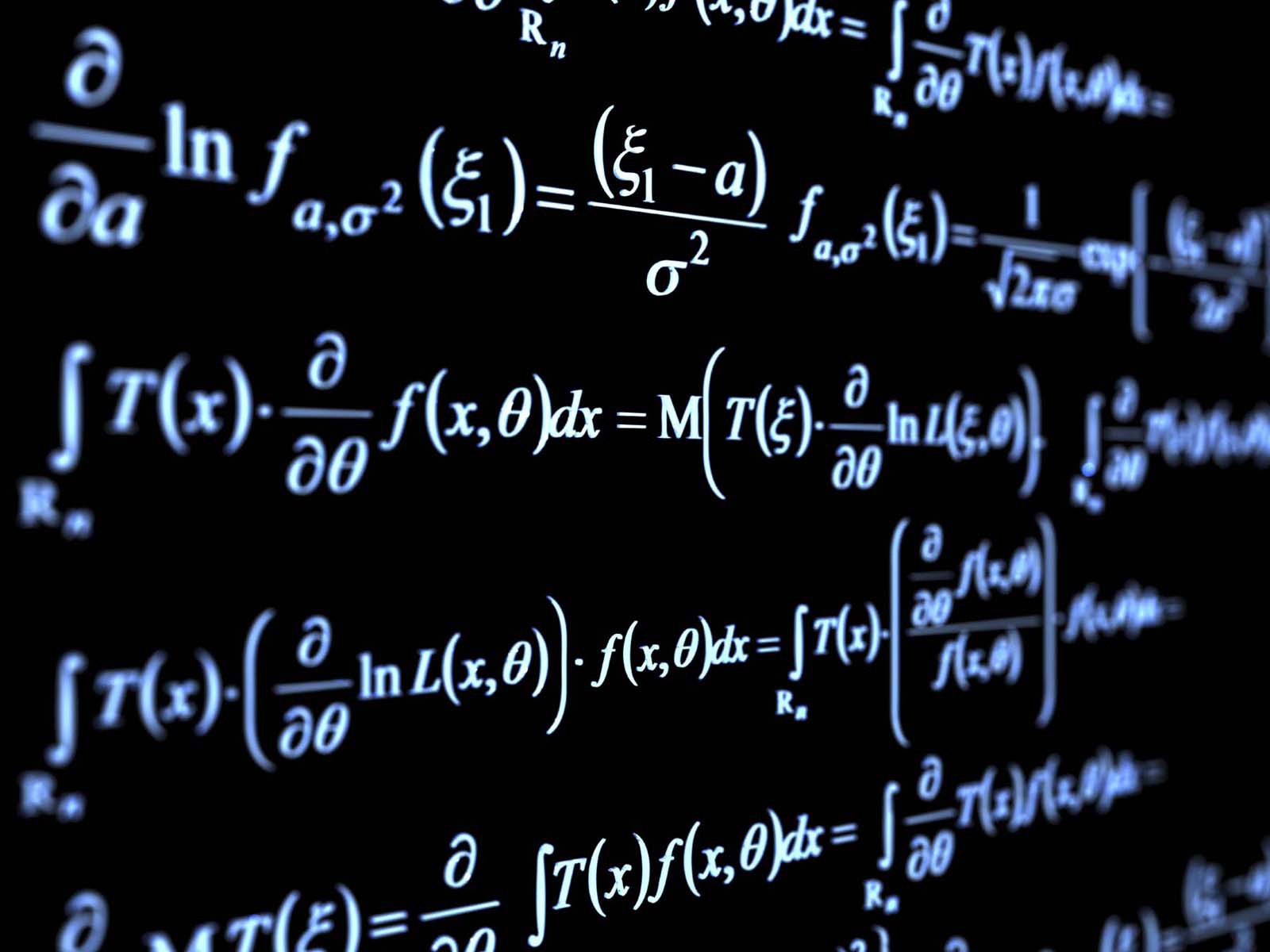
Non-empirical knowledge is well-known to us from mathematics. It is commonly held that the truth of the statement 2+2=4 is independent of the natural world. Once we understand what the symbols mean, it is impossible to deny its truth, whether or not we ever make any observation. This kind of proposition is sometimes called analytic.
Mathematical truths are not about nature in the sense that, say, the laws of gravity are. Brown's surprising thesis is thus that thought experiments can provide a priori knowledge of the laws of nature, in much the same way that we come to know about mathematics.
How can we detect such truths? If none of our senses are providing the information about them, then how do we come to know them?
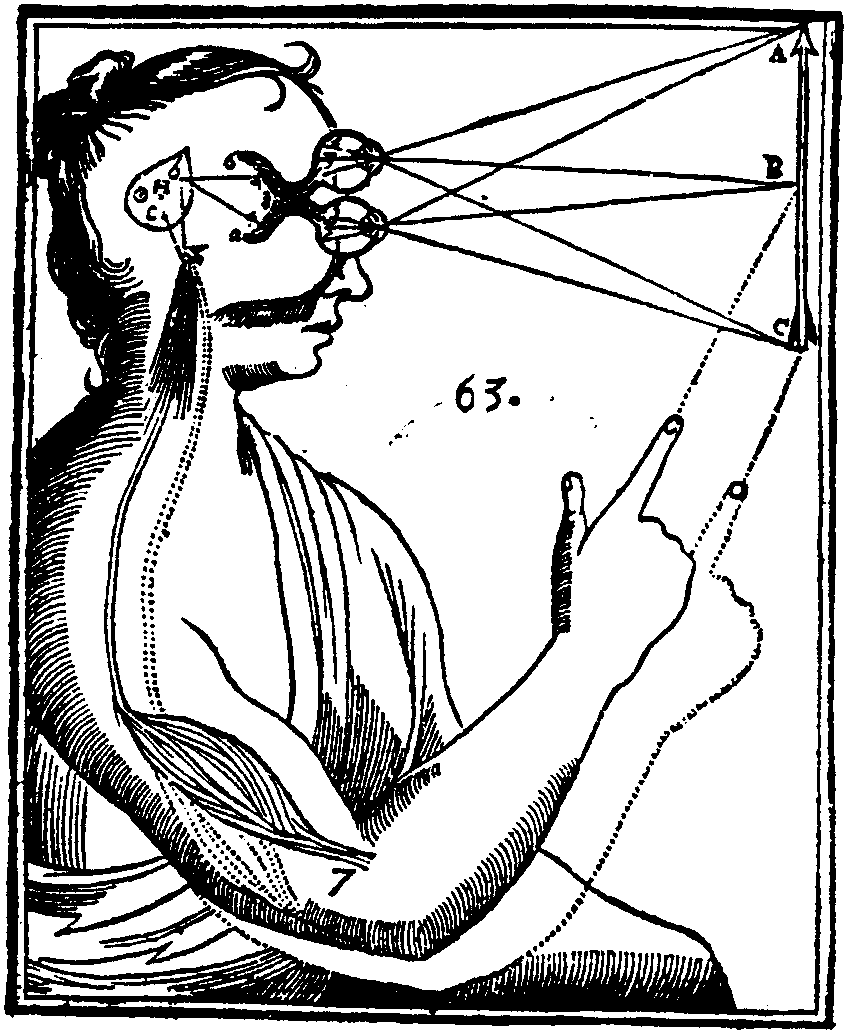
It is hard to see how this question can be adequately answered by the non-empiricist. Brown has suggested that there must be a special brain capacity that allows one to access these truths. But what is the basis for such a capacity? No neurological evidence for it appears to exists, at least not in the sense that evidence exists for other sense experiences like vision or hearing.
We will return to this view more shortly. But first, the alternative view.
The Empiricist View
John Norton an alternative, empiricist perspective on thought experiments. The central claim is:
Empiricist View of Thought Experiments
Thought experiments are just arguments.
There is a lot in this simple idea for us to unpack.
First, what is an argument? It is a set of premises that, when true, lead inevitably to the truth of a conclusion. For example, this is an old favourite due to Socrates.
- All people are mortal.
- Socrates is a person.
- Therefore, Socrates is mortal.

According to the empiricist view, all thought experiments are arguments in this sense. There are two main consequences of this.
First, a thought experiment must somewhere contain a set of premises, implicit or explicit. Because thought experiments are often expressed in vivid pictorial or narrative form, this is not always obvious. But on the empiricist view, every true thought experiment can be formulated as a set of premises that lead to a conclusion. And those premises come from either logic and mathematics or from empirical observation.
Second, when someone asks what justifies a given thought experiment, the empiricist answer is that the only justification is the strength of the argument. We are justified in believing the conclusion of a thought experiment only to the extent that it is a good argument (explicitly or implicitly).
For example, Galileo's falling mass argument can be formulated as follows.
- Suppose (for reductio ad absurdum) that a heavier mass falls faster than a lighter mass.
- A small and large mass tied together are heavier than either one by itself.
- Thus, two masses tied together fall faster the large mass alone (by 1).
- If two objects tied together have different initial speeds, then the faster object will slow and the slow object will speed up to reach some intermediate speed.
- A small and large mass tied together have different initial speeds (by 1).
- Thus, the two masses tied together will fall slower than the large mass alone. (Contradiction.)
- Therefore, a heavier mass does not fall faster than a lighter mass.

On the empiricist view, Galileo's thought experiment is actually just this argument (or something similar) in disguise. Not all of the premises are explicit, such as Premise 4, which is tacitly presumed.
As such, the thought experiment is only as good as its premises. Since they are all plausible (except for the first one, which is the reductio hypothesis), the thought experiment is a convincing one.
Hawking's big bang thought experiment, like Galileo's falling bodies, can be formulated as an argument as well. If you are interested, you can see a readable sketch of that argument here. Hawking formulated this argument as a mathematical theorem as part of his PhD thesis.
Understanding thought experiments: A criterion of adequacy
How are we to judge an account of thought experiments? How are we to say whether (for example) Norton's empiricist view or the non-empiricist view are more plausible?
Here is perhaps the most minimal demand: an account of thought experiments should not allow contradictions. In particular, if two thought experiments reach contradictory conclusions, then an adequate account of thought experiments must be able to say why at least one of the thought experiments fails.
One way to make this idea vivid is to consider a thought experiment / anti-thought experiment pair.

A thought experiment / anti-thought experiment pair is a pair of thought experiments that reach opposite conclusions. An adequate account of thought experiments ought to be able to say why one or the other is wrong, or why both are, in order to avoid contradiction.
Compare this to the situation with regular experiments. In 2011, an experiment at the Large Hadron Collider suggested neutrinos move faster than light. This contradicted years of experiments showing that neutrinos do not move faster than light. The result was two contradictory experimental conclusions: those providing evidence that neutrinos do not move faster than light, and the new experiment providing evidence that neutrinos move faster than light.
This contradiction led to an immediate reexamination of the relevant experiments. Though it took several months to find, it was eventually discovered that the culprit was the neutrino experiment: a cable was not plugged in correctly. The neutrino experiment was thus found to have been carried out incorrectly, and when it is repeated with the cable plugged in, the anomaly disappeared, and the contradiction was resolved.

The problematic cable (Source)
Some analogous explanation of contradictory thought experiments must be possible as well, if we are to avoid contradictions. The question is: how? Let's think through some examples.
Example 1: The elevator
In one thought experiment, the best strategy for surviving an elevator crash was to lay flat on the ground. In another thought experiment, the best strategy was to stand and do a PLF. These thought experiments reach opposite conclusions about surviving an elevator crash.
Only one of them can be right. And any account of how we learn things from thought experiments must allow us to explain why at least one of them is wrong.
Example 2: Infinite space
The Pythagorean philosopher Archytas argued that space is infinite by imagining what would happen if space were finite. It seemed absurd not to say that you can always reach your hand out in front of you. Thus, if space were finite, it would seem that you could reach your hand out and pass it through the boundary. But then your hand would be nowhere at all, having passed outside of space, which is also absurd. Therefore, the argument goes, space cannot be finite.

19th century woodcut created for Camille Flammarion
Aristotle argued for exactly the opposite, by imagining what would happen if space were infinite. In particular, it would allow for the existence of infinite parallel lines.

But in that case, if I were to rotate one of the lines, then there would be no first moment at which it intersects the second line. This seemed impossible to Aristotle. Therefore, he concluded, space cannot be infinite.
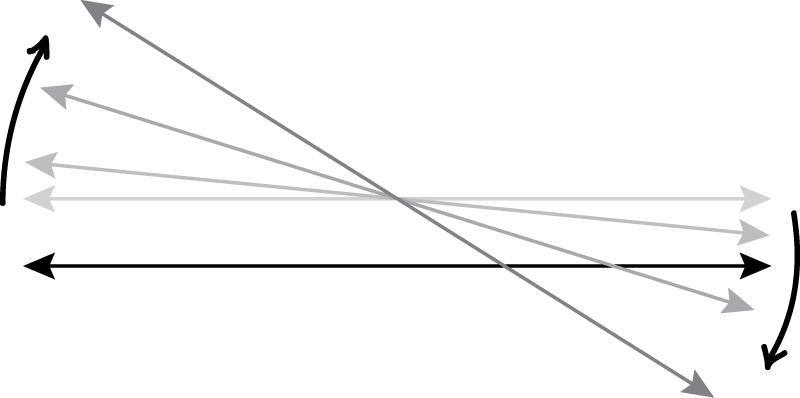
These two thought experiments cannot both be right, since they reach contradictory conclusions. So, whatever account of thought experiments that we adopt, it must allow us to say why one or the other is wrong.
Which view of thought experiments is adequate?
The empiricist view of thought experiments allows one to say why one of a pair of contradictory thought experiments is wrong: because it gives a bad argument. An argument is bad if it has insufficiently supported premises, or if it is invalid. Thus, if thought experiments are just arguments, then having two contradictory thought experiments can be explained by showing that at least one of the premises is wrong, or that the argument is invalid. The empiricist view thus appears to satisfy the criterion of adequacy.
It is less clear whether the non-empiricist view of thought experiments satisfies this criterion. If thought experiments are just our accessing nature without observation, how do we adjudicate them? How can we tell when one is right and one is wrong? This suggests that the non-empiricist view is not by itself adequate; something else is needed, or else (as Norton argues) it should be rejected.
How should we characterise thought experiments? There are other ways besides the ones discussed here, some of which you may find discussed in the Norton reading. I leave it for you to decide.
What you should know
- Examples of thought experiments in life and in science
- The epistemological problem of thought experiments
- The 'Beyond Empiricism' view of thought experiments
- The Empiricist view of thought experiments
- Thought experiment / anti-thought experiment pairs
- How to adjudicate when an account of thought experiments is adequate
« Back to Chapter 16
On to Chapter 18 »

















